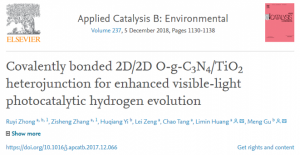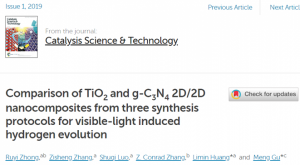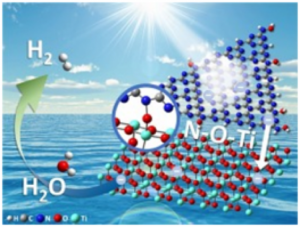SUSTech undergraduate publishes groundbreaking interdisciplinary papers
2019-07-03
The sun, the ultimate energy source of solar system, provides our mother planet with 120 000 TW annually through electromagnetic radiation. Utilization of solar energy by photocatalysis is considered as one of the most promising strategies to meet the increasing energy and environmental demand of human society. In the 1970s, Fujishima and Honda split water into hydrogen and oxygen on sensitized TiO2 photoanode under irradiation. Since then, the solar-to-fuel conversion through semiconductor photocatalysis has been intensively studied.

Recently, Southern University of Science and Technology (SUSTech) undergraduate Zisheng Zhang (2019) published his research as an outcome of the innovation project from the Department of Chemistry. His research on photocatalytic hydrogen production was conducted within the research groups of Prof. Meng Gu from the Department of Materials Science and Engineering and Prof. Limin Huang from the Department of Chemistry. Working with postdoctoral researcher Ruyi Zhong, their research was published as cover articles for two academic journals, Applied Catalysis B: Environmental (IF = 14) and Catalysis Science & Technology (IF = 5.4). With his outstanding papers, he has earned a full scholarship to the University of California, Los Angeles (UCLA).

The paper in Catalysis Science & Technology was entitled “Comparison of TiO2 and g-C3N4 2D/2D nanocomposites from three synthesis protocols for visible-light induced hydrogen evolution.”
The researchers applied three distinct and typical approaches to fabricate TiO2 and g-C3N4 2D/2D nanocomposites. All three heterostructures exhibited higher photocatalytic activities towards the hydrogen evolution reaction under visible light irradiation, compared to the physical mixture of the corresponding g-C3N4 and TiO2 nanosheets. The formation of covalent Ti-O-N is evidenced to more efficiently facilitate the migration and separation of photoinduced charge carriers compared to electrostatic or van der Waals interactions, thus being more beneficial for H2 evolution. The maintenance of the large surface area outweighed the surface-cleanliness and crystallinity of the TiO2 component in the composites. The well-designed comparative experiments and detailed characterization in this work may pave the way for rational design and synthesis of other composite materials with well-defined heterostructures for versatile applications.
Link to original paper – https://pubs.rsc.org/en/content/articlelanding/2019/cy/c8cy00965a#!divAbstract

The paper in Applied Catalysis B: Environmental is entitled “Covalently bonded 2D/2D O-g-C3N4/TiO2 heterojunction for enhanced visible-light photocatalytic hydrogen evolution.” Among the extensively studied narrow band-gap photocatalysts, graphitic carbon nitride (g-C3N4) has been recently acknowledged as the next-generation photocatalyst by the research community. g-C3N4 is noted for its photostability and chemical tunability. Constructing well-fabricated g-C3N4/TiO2 nanocomposite with enhanced visible-light response is therefore becoming an emerging trend, and lots of synthetic attempts have proven to be successful. Most investigations focused on tailoring the composition rather than modifying the interaction type that defines a heterojunction interface.
The two researchers presented a novel self-assembled 2D/2D O-g-C3N4/TiO2 composite with enhanced visible-light photocatalytic activity for HER. The in situ solvothermal synthesis is convenient, cost-effective and fluorine-free. The 2D nature of individual components of the composite gives it large specific surface areas, pronounced quantum confinement effect and exposed active sites for visible-light photocatalytic hydrogen evolution.
Link to original paper – https://www.sciencedirect.com/science/article/pii/S0926337317312146

Professor Limin Huang’s research group provided the sufficient and advanced experimental conditions for the synthesis of catalysts. The visible characterization of the nanostructures benefits from Professor Meng Gu’s expertise in electron microscopy and the advanced laboratory equipment at the Pico Electron Microscopy Center at SUSTech.
Zisheng Zhang said that he had evolved from a rookie researcher into a veteran scientist familiar with many different types of laboratory instruments. “This field involved the study of chemistry, materials science, physics – such an interdisciplinary approach greatly broadened my knowledge and got me used to the atmosphere of cooperation. It will help me with my doctoral studies.” Zisheng Zhang was very thankful for the tireless help and guidance of Professors Meng Gu and Limin Huang, who assisted him throughout his research.
Zisheng Zhang and Ruyi Zhong were the first authors of both papers. Professors Gu Meng and Huang Limin were the communication authors. SUSTech is the communication unit for both papers.
The papers were supported by the SUSTech Start Fund through the Shenzhen Peacock Talent Program, the Basic Research Fund of Shenzhen, the Technical Research Fund of Shenzhen, the National Nature Science Foundation of China and the Guangdong Innovative and Entrepreneurial Research Team Program. Both works receive support from the SUSTech Pico Center and the High Performance Computing Center at SUSTech, which receive support from the Presidential Fund and the Shenzhen Municipal Development and Reform Commission.




